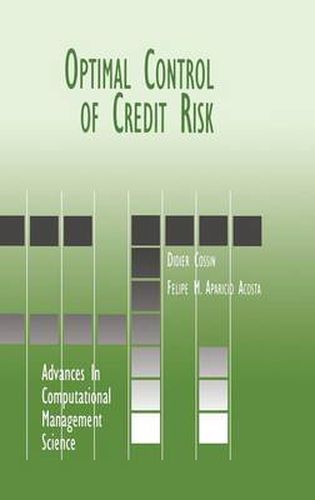Readings Newsletter
Become a Readings Member to make your shopping experience even easier.
Sign in or sign up for free!
You’re not far away from qualifying for FREE standard shipping within Australia
You’ve qualified for FREE standard shipping within Australia
The cart is loading…






This title is printed to order. This book may have been self-published. If so, we cannot guarantee the quality of the content. In the main most books will have gone through the editing process however some may not. We therefore suggest that you be aware of this before ordering this book. If in doubt check either the author or publisher’s details as we are unable to accept any returns unless they are faulty. Please contact us if you have any questions.
This title presents an alternative methodology to deal with a financial problem that has not been well analyzed yet - the control of credit risk. Credit risk has become the centre of interest of the financial community, with new instruments (such as credit risk derivatives) and new methodologies (such as credit metrics) being developed. The recent literature has focused on the pricing of credit risk. On the other hand, practitioners tend to eliminate credit risk rather than price it. They do so via collateralization. The authors offer methodological basis for an optimal collateralization. The monograph is organized as follows: chapter 1 reviews the main avenues of literature related to our problem; chapter 2 provides a brief overview of the main optimal control principles; and chapter 3 presents the models and their setting. In the remaining chapters, the authors propose two sets of programmes. One set of programmes will apply in cases where the information on the assets=value is readily available (full observation case), while the other applies when costly audits are needed in order to assess this value (partial observation case). In either case, the modelling stage leads to a set of quasi-variational inequalities which the authors attempt to solve numerically in the simpler case of full observations. This is done in chapter 6. Finally a simulation analysis is carried out in chapter 7, in which the authors study the influence on the control process of changes in the different model parameters. This precedes a discussion on possible extensions in chapter 8 and some concluding remarks in section 9.
$9.00 standard shipping within Australia
FREE standard shipping within Australia for orders over $100.00
Express & International shipping calculated at checkout
This title is printed to order. This book may have been self-published. If so, we cannot guarantee the quality of the content. In the main most books will have gone through the editing process however some may not. We therefore suggest that you be aware of this before ordering this book. If in doubt check either the author or publisher’s details as we are unable to accept any returns unless they are faulty. Please contact us if you have any questions.
This title presents an alternative methodology to deal with a financial problem that has not been well analyzed yet - the control of credit risk. Credit risk has become the centre of interest of the financial community, with new instruments (such as credit risk derivatives) and new methodologies (such as credit metrics) being developed. The recent literature has focused on the pricing of credit risk. On the other hand, practitioners tend to eliminate credit risk rather than price it. They do so via collateralization. The authors offer methodological basis for an optimal collateralization. The monograph is organized as follows: chapter 1 reviews the main avenues of literature related to our problem; chapter 2 provides a brief overview of the main optimal control principles; and chapter 3 presents the models and their setting. In the remaining chapters, the authors propose two sets of programmes. One set of programmes will apply in cases where the information on the assets=value is readily available (full observation case), while the other applies when costly audits are needed in order to assess this value (partial observation case). In either case, the modelling stage leads to a set of quasi-variational inequalities which the authors attempt to solve numerically in the simpler case of full observations. This is done in chapter 6. Finally a simulation analysis is carried out in chapter 7, in which the authors study the influence on the control process of changes in the different model parameters. This precedes a discussion on possible extensions in chapter 8 and some concluding remarks in section 9.